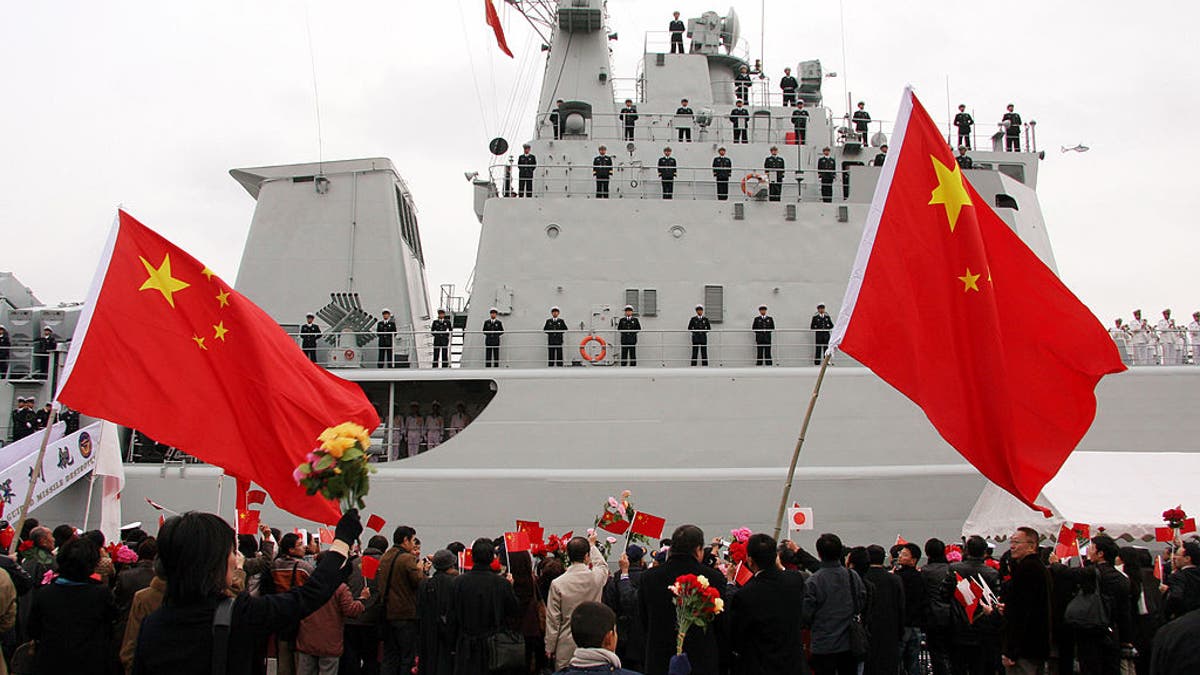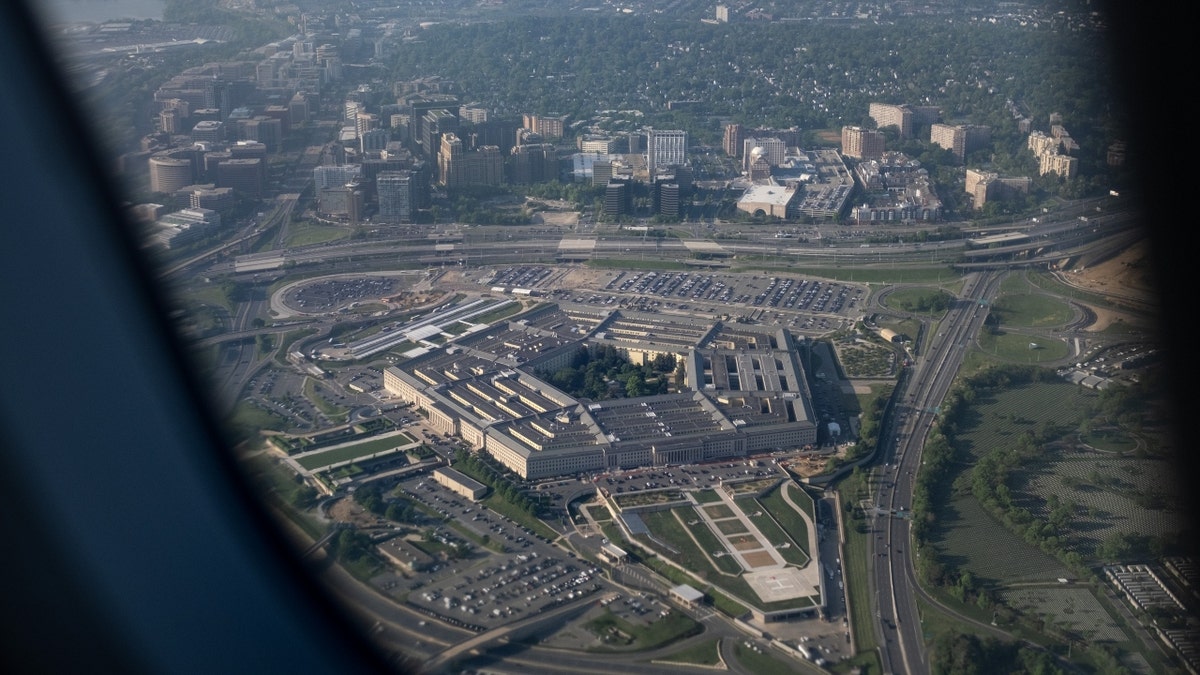Americans rescued by US Navy in Sudan arrive in Saudi Arabia
Fox News Benjamin Hall reports on the evacuations and his exclusive interview with Secretary of State Antony Blinken airing Monday on "Special Report."
A U.S. Office of Naval Intelligence (ONI) slide that was leaked online highlights concerns over a rapidly expanding Chinese navy and the country's continued capability to produce ships at a faster rate than the United States.
"The Chinese see this decade as a strategic opportunity," Brent Sadler, senior research fellow for naval warfare and advanced technology in the Center for National Defense at the Heritage Foundation, told Fox News Digital. "I don't see any near-term bending of the curve where we actually start closing the gap with the Chinese."
Sadler's comments come after images of the unclassified Office of Naval Intelligence slide have been widely circulated around the internet. The image, which was picked up in a War Zone report, show China's massive shipbuilding capacity as compared to the United States.
The slide's authenticity was confirmed by a Navy spokesperson, who cautioned that it was not meant to be an in-depth analysis.
"The slide was developed by the Office of Naval Intelligence from multiple public sources as part of an overall brief on strategic competition," the spokesperson told Fox News Digital. "The slide provides context and trends on China’s shipbuilding capacity. It is not intended as a deep-dive into the PRC (People's Republic of China) commercial shipbuilding industry."
The slide shows that Chinese shipyards have a capacity of about 23.2 million tons compared to less than 100,000 tons in the U.S., making Chinese shipbuilding capacity more than 232 times greater than that of the U.S.
CCP-TIED EV COMPANY BACKED BY DEMS BUYS UP MICHIGAN LAND MILES FROM US MILITARY BASES

A crowd waves flags to welcome the Shenzhen, a Chinese Type 051B Luhai-class missile destroyer, upon its arrival in Tokyo. (Haruyoshi Yamaguchi / Bloomberg)
The slide also shows the "battle force composition" of the countries' two navies side-by-side, which includes "combatant ships, submarines, mine warfare ships, major amphibious ships, and large combat support auxiliary ships." The ONI estimated that China had 355 such naval vessels in 2020 while the U.S. had 296. The disparity is expected to continue to grow every five years until 2035, when China will have an estimated 475 naval ships compared to 305-317 U.S. ships.
Another section of the slide provides an estimate on the percentage each country allocates to naval production in its shipyards, with China garnering roughly 70% of its shipbuilding revenue from naval production, compared to about 95% of American shipbuilding revenue.
However, that disparity is also concerning, Sadler said, who noted that China would gain a strategic advantage by having a robust commercial shipbuilding sector.
"Shipbuilding is a strategic industry, and they realized that a long time ago," Sadler said of China. "The first part was build up your commercial shipbuilding sector … commercial shipbuilding really was the genesis for all of this massive capacity. It's a lesson that you can't have naval shipbuilding without a commercial shipbuilding sector and the Chinese have been doing that for 30 years."
Because of China's centrally planned economy, the country is able to control labor costs and provide subsidies to its shipbuilding infrastructure, allowing the Chinese to outbid most competitors around the world and dominate the commercial shipping industry, Sadler said.
US, AUSTRALIA, JAPAN, GERMANY SHOW FORCE DURING MILITARY EXERCISE AMID CHINA FEARS
On the military side, Sadler noted that the Chinese began to acquire technology from the Soviet Union, later Russia, and Ukraine, modeling many of their naval vessels after technology from those countries.
"Then you get more shipyard workers, and sometimes these commercial shipyards, one side's building tankers, LNG ships and container ships, and right next door, they're building cruisers and destroyers, sometimes with the same shipyard workers," Sadler said.
Sadler argued that the U.S. has not built a comparable shipbuilding infrastructure because builders only have the U.S. government as a customer.
"The federal government is the sole customer … your biggest customer where you get your biggest margin of profit is building the big high-tech expensive naval ships," Sadler said. "That's the only show in town for us. And unfortunately, because that's the case, no one's looking to get competitive and building better container ships or the next generation commercial shipping vessel, which is what we really need to be doing."

The USS Theodore Roosevelt leaves its San Diego home port. (U.S. Navy via Getty Images)
While much of the attention on China's advantage in shipbuilding has been focused on the country's naval capabilities, Sadler said that the Chinese advantage in commercial shipping also has large implications on U.S. security and the economy.
"In peacetime, the everyday family is just trying to get diapers, baby formula, bottles of water, toilet paper, or during COVID, PPE, masks. A lot of that supply chain, the ships, the movement, the shippers, they're tied to the Chinese market or they're Chinese ships," Sadler said.
"We had backlogs of containers in China because it was more profitable to hold cargo in China," Sadler added. "It caused a backlog of supply. There were situations many people probably still recall of empty shelves. Part of the reason for that was an over reliance on this global supply chain overwhelmingly centered in China."
US NAVY’S 19K-TON CARGO SHIP RUNS AGROUND IN BAHRAIN
That dominance in commercial shipping also plays out when it comes to a potential conflict, Sadler added, arguing that the over-reliance on Chinese shipping would allow China to "sanction us very effectively" in response to hypothetical U.S. sanctions if they were to get more aggressive around Taiwan.
"The United States relies on 80,000-plus visits to keep its economy by foreign flag vessels, to keep the lights on … the stores and industries humming," Sadler said. "So, if the Chinese basically deal themselves out of that market, we lose the ability to sustain our economy, and the shocks of that are really not fully appreciated."
Reports this week by the South China Morning Post indicate that China may be closing in on building another giant warship, with online images showing workers at the Hudong-Zhonghua shipyard holding flags next to what appears to be a next-generation amphibious assault ship.
In a potential direct conflict with China, Sadler argued that the implications of shipbuilding disparity would be "even more dire," pointing to possible rations similar to World War II. The consequences of the situation could also be felt in a battle at sea, where China would have the ability to produce, repair and replace naval vessels at a faster rate than the United States.
Despite the looming threat, Sadler said the U.S. has not worked toward the goal of increasing the number of U.S. naval vessels.
"Every budget for the last three years during the Biden administration … the long-range plans have all laid out a reduction in the size of the Navy when the danger is going in the other direction, it's going up," Sadler said.
According to an Association of the United States Navy report earlier this year, President Biden's proposed fiscal year 2023 budget called for a reduction of 15 vessels from the Navy's fleet. While the proposal allowed funding to build nine new vessels, it also proposed a decommission of 24 ships, leading to the overall reduction of the fleet.

President Joe Biden (Brendan Smialowski / AFP via Getty Images / File)
NAVY PILOT MADE CRUCIAL ERROR BEFORE CRASHING F-35C INTO USS CARL VINSON IN SOUTH CHINA SEA
Biden's fiscal year 2024 budget also called for an elimination of 11 ships, a plan that was criticized by Sen. Roger Wicker, R-Miss., the ranking member on the Senate Armed Services Committee.
"We should rapidly work to expand our naval fleet," Wicker said in a press release earlier this year. "As I said, China’s fleet size has eclipsed ours, and yet the Department of Defense proposes ship decommissionings. The Marine Corps was unable to assist victims of the earthquakes in Turkey just a few months ago because the Navy lacked enough amphibious ships."
Wicker was at the center of a 2017 effort to set a goal of achieving a 355-ship naval fleet, a proposal that became law in the 2018 National Defense Authorization Act after it was signed by former President Donald Trump.
But budget proposals in the years since have fallen short of meeting those expectations, including Biden's 2024 proposal that called for the 11-ship reduction.
Speaking to reporters about the proposed reduction earlier this year, Rear Adm. John Gumbleton said eight of the 11 ships were being eliminated before their "end-of-service-life" as a result of the ships' "material condition, life remaining, cost and then time to upgrade."
"These six vessels did not pass that ROI analysis. In addition to the time and money saved with this divestment, we will also free up over 1,500 sailors to support higher-priority efforts," Gumbleton said.

The Pentagon (Tom Brenner / Bloomberg via Getty Images / File)
CLICK HERE TO GET THE FOX NEWS APP
Asked about the Navy's fleet continuing to hover below 300 ships during the same briefing, Under Secretary of the Navy Erik Raven told reporters that "readiness, modernization … and capacity, in that order, are the priorities that … drive this budget."
"We are constantly working with our industrial partners to make sure that we are not only funding but taking delivery of ships on time and in an efficient manner," Raven said.
The White House did not immediately respond to a Fox News request for comment.
According to Sadler, the failures of the U.S. to adequately invest in its shipbuilding capacity have not been "a partisan issue." He argued that "both parties' political leaders have failed on this count."
Sadler added that lawmakers need to "get serious about the threat" and "put plans and budgets that … grow the Navy."
"We need consistency in the budgets," Sadler said. "We need to find a way to regain a competitive edge so that there is a reason, a profitable market space for young Americans to want to join something that's new, that's exciting, and they can make a really good living in shipping in shipbuilding. Right now, that just doesn't exist."





















